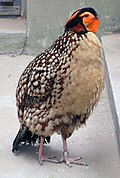| Tragopan | |
|---|---|
 | |
| Blyth's tragopan (Tragopan blythii) | |
| Scientific classification | |
| Kingdom: | Animalia |
| Phylum: | Chordata |
| Class: | Aves |
| Order: | Galliformes |
| Family: | Phasianidae |
| Tribe: | Lophophorini |
| Genus: | Tragopan Cuvier, 1829 |
| Type species | |
| Meleagris satyra (satyr tragopan) Linnaeus, 1758 | |
Tragopan is a bird genus in the pheasant family Phasianidae. Member of the genus are colloquially called "horned pheasants" because males have two brightly colored, fleshy horns on their head that can be erected during courtship displays, despite this name, they are not true pheasants and are not closely related to them. The habit of tragopans to nest in trees is unique among phasianids. [1]








